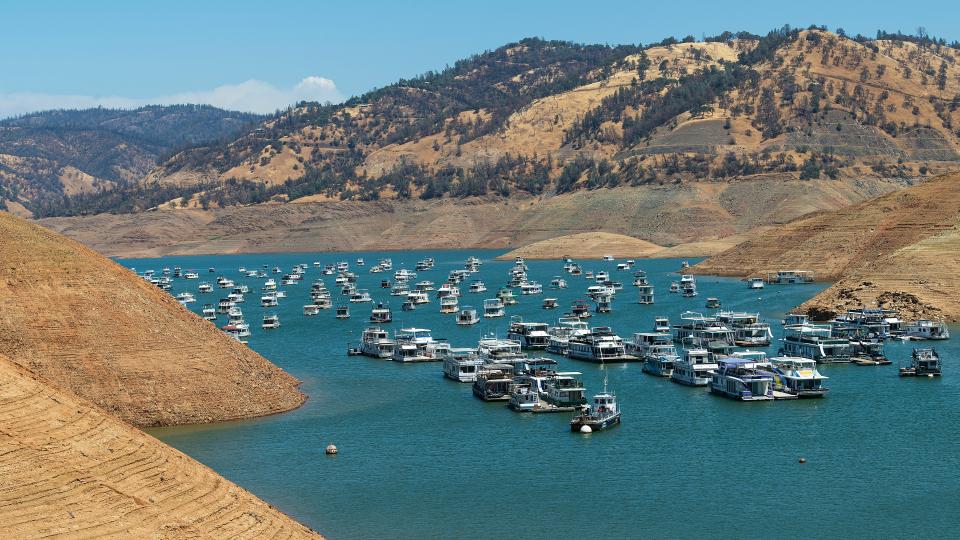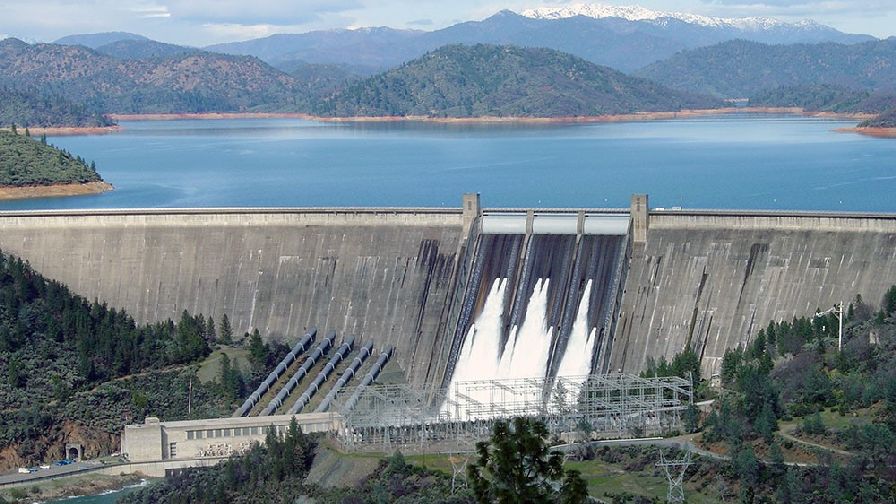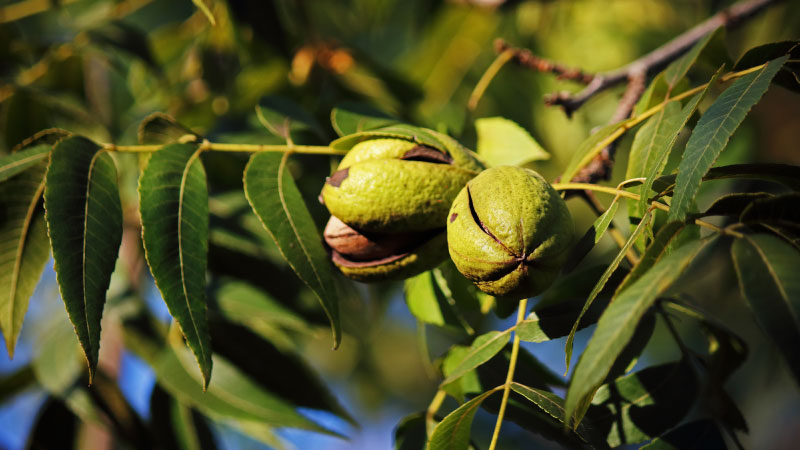California Growers Demand Action on State’s Water Supply

Water in California is becoming more of a premium every day. Even the state’s second-largest reservoir, Lake Oroville, with a capacity of 3.5 million acre-feet, didn’t have enough water for all the boats normally moored there last year by late July.
Photo by Andrew Innerarity, California Department of Water Resources
More than 400 Californians attended an event titled “Save Our Communities” in the San Joaquin Valley town of Visalia to discuss the immediate impending impacts of the state’s Sustainable Groundwater Management Act (SGMA) to the communities in the valley. A total of 53 organizations co-hosted the event, including the California Fresh Fruit Association, American Pistachio Growers, and the Western Agricultural Processors Association, whose President/CEO, Roger Isom, gave the opening remarks at the event, stating, “The time to act is now.”
Isom noted the state’s Sustainable Groundwater Management Act (SGMA) was passed in 2014. The state required the state’s Groundwater Management Areas (GMAs) to submit sustainability plans this year. However, GMAs have found their respective regions have sustainable yields that are too low to provide adequate amounts for farming – largely because they simply don’t have enough access to water.
The reason? Isom notes that in the same year SGMA was passed, 2014, the state passed the multi-billion-dollar water bond act. Many agricultural groups helped successfully campaign for the bond act, thinking it would fund new water storage, such as reservoir construction, as well as such actions as groundwater recharge projects, injecting flood waters into underground aquifers that have been depleted.
“We knew it was going to restrict groundwater pumping,” says Isom. “We were in the middle of a drought back then, we had wells going dry. Everyone knew we need SGMA, but no one knew who how bad it would be.”
Isom says only one significant water storage project has emerged as a result of the bond act. The Sites Reservoir is a proposed $5.2-billion off-stream reservoir project west of Colusa in the Sacramento Valley of northern California that will capture excess water in wet years, but California hasn’t seen many of those in recent times. However, the project won’t break ground until 2024 and won’t have any significant storage until about 2039.
“No new significant water storage facility has been built in California since 1979, the New Melones Reservoir (near Modesto),” he says. “Fast forward to 2022, we’re in the third year of devastating drought, and the water bond has basically fallen apart.”
Since its passage in 2014, state agricultural leaders have pushed for such ideas as the Twin Tunnels Project. This massive plan called for pulling water from up above the Sacramento Delta, bypassing the famed endangered Delta Smelt, and delivering the water to thirsty Southern California users, including desperate San Joaquin Valley farmers.
There was also the federal Water Infrastructure Improvements for the Nation Act (WIIN Act) of 2016, which was designed to improves America’s drinking water infrastructure. The WIIN Act provides federal funding for such projects as raising the Shasta Dam, as Shasta Lake is one of the state’s two largest reservoirs along with Lake Oroville.
The “Save Our Communities” event is being held just as the state moves into what is traditionally known as the “dry season,” as the state gets very little rainfall outside of winter. But the U.S. Drought Monitor reported this week that Shasta and Oroville were entering the dry season – when they are supposed to be at their highest – at critically low levels. Oroville is at 55% of total capacity, which is 70% of where it should be around this time, and Shasta is at just 40%, the lowest it has ever been at the start of May since record-keeping began in 1977.

Shasta Dam, which is allegedly slated for expansion, is in Northern California, where it creates the state’s largest reservoir, Shasta Lake. It’s at its lowest point this time of year since record-keeping began in 1977.
Isom says he doesn’t know exactly where all the water bond act money of 2014 went, but it was spread among a lot of projects. “It’s not the big storage projects that got the funding,” he says, “let’s put it that way.”
Isom, like most in California agriculture, believe environmentalists are simply going too far. Isom says now that groundwater is not an option for growers in many areas in the San Joaquin Valley, additional water storage is necessary. There’s absolutely no way around it.
“I know it sounds harsh, I know it’s way out there, but there is simply a big segment that doesn’t want farming in California,” he says. “They may not say that, but blocking these water projects has that effect.”
Isom says this attitude fails to consider the importance of California agricultural production. Because of climate, much of the state’s production would have to move outside the U.S., and that raises a whole host of issues.
For example, growers in many other countries use pesticides that are not allowed in they U.S. Isom says he and his staff check FDA reports of import violations, not just of high pesticide residues but also banned chemicals. “Some of them show DDT,” he says. “DDT – when was that banned in the U.S.?”
Many of the pesticides aren’t used in California at all. He notes that California growers, in fact, are the only growers in the U.S. that must report every pesticide usage. Those strict controls over pesticides will have no meaning if we begin importing more fruits and vegetables, as they will be produced somewhere with far more relaxed regulations.
There are many other issues involved with increasing the importation of fruits and vegetables, he says. For example, we are rightly concerned about the treatment of farmworkers in the U.S., whereas in some competing countries, child labor is common. Isom wonders if those social effects have been thought out.
“It’s just a lack of understanding how important ag is, to this state, and to this country,” he says.
But that is the future, and Isom says the crowd of 400-plus that came out in Visalia was swelled by the fact that the issue is really hitting home now that the GMAs – which many growers already are concerned are too harsh in their restrictions – are being rejected for not being tough enough.
“Farmers are saying, ‘Now you’re telling me I can only pump half an acre-foot? I can’t produce a crop with that,’” he says. “You know what happens when you can’t produce a crop? You default.”
Many growers won’t even get that far next year. Though most are safe this year, another year of drought and all bets are off. Many bankers attended the Visalia meeting, and they told growers in attendance if they can’t show access to enough water to produce a crop, they won’t get the necessary loans.
Isom says it’s difficult to grasp the enormity of the problem, and how fast it is accelerating. It wasn’t long ago that forecasts of leaving 500,000 acres fallow this year were dire, now estimates of 1 million acres are considered closer to the truth. This is no longer about avoiding or minimizing the problem, it is about tackling the water shortage before people’s livelihoods are destroyed.
“This isn’t a matter of ‘We will conserve our way out of this,’” he says. “This is about if we don’t find any additional water, these people may be done farming.”









